目录
前言
Exchange(交换机)的类型与应用
- 交换机的属性
1. 直连交换机:Direct Exchange
2. 主题交换机:Topic Exchange
3. 扇形交换机:Fanout Exchange
4. 默认交换机(直连)
前言
在讲交换机之前我们需要了解一些概念,在RabbitMQ工作流程有一项叫Exchange(交换机:消息的分发中心),它的作用是将生产者发送的消息转发到具体的队列,队列再将消息以推送或者拉取方式给消费者进行消费。
原:在RabbitMQ中生产者发送的信息不会直接投递到队列中,而是先将消息投递到交换机中,在由交换机路由到一个或多个队列中。
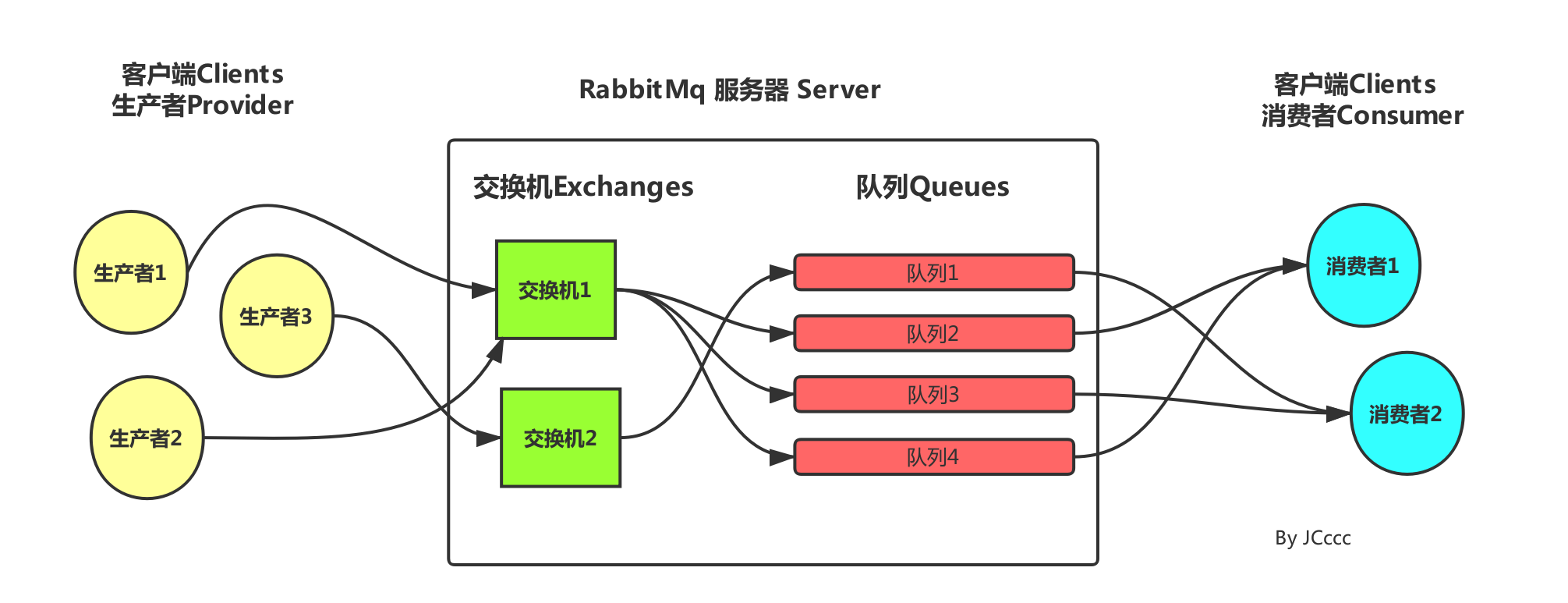
流程:生产者 --(路由键)---> 交换机 --(绑定键)---> 队列 --(pull,push)--->消费者
这里就需要了解这两个东西:
路由键(RoutingKey):每个消息都有一个称为路由键(routing key)的属性,它其实就是一个简单的字符串(或者可以说是一种规则的字符串)绑定键(BindingKey):就是指定将队列跟接收路由键的交换机进行绑定生产者将信息发送给哪个Exchange是由RoutingKey决定的,而Exchange与哪个队列绑定是由BindingKey决定的。
Exchange(交换机)的类型与应用
- 交换机的属性
除交换机类型外,在声明交换机时还可以附带许多其他的属性,其中最重要的几个分别是:
Type:交换机名称Durability:是否持久化。如果持久性,则RabbitMQ重启后,交换机还存在Auto-delete:当所有与之绑定的消息队列都完成了对此交换机的使用后,是否删掉它Internal:当前Exchange是否用于RabbitMQ内部使用,默认fasleArguments:扩展参数这里就直接开始操作,配置在一篇就已做了讲解,非常简单!接下来的代码也之上在原基础上做了添加。
项目结构:
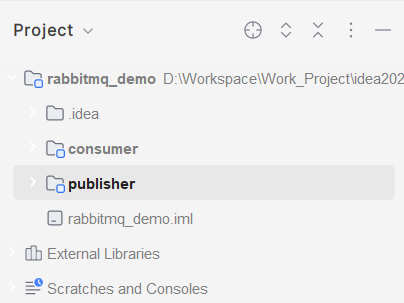
所需依赖:
<!--amqp协议--> <dependency> <groupId>org.springframework.boot</groupId> <artifactId>spring-boot-starter-amqp</artifactId> </dependency> <dependency> <groupId>org.springframework.boot</groupId> <artifactId>spring-boot-starter-web</artifactId> </dependency> <dependency> <groupId>org.projectlombok</groupId> <artifactId>lombok</artifactId> <optional>true</optional> </dependency>
1. 直连交换机:Direct Exchange
这是最简单的一种交换机类型。当一个队列与交换机绑定时,需要指定一个路由键(RoutingKey),只有当消息的路由键与该队列绑定时指定的绑定键(BindingKey)完全匹配时,消息才会被路由到该队列。如下图:
一、p发送消息时带了一个叫black的routing_key,交换机接受后会送到与black绑定的binding_key的队列中,也就是Q2。以此类推...
二、还有一种情况,当Q2也与交换机绑定了black,这时p发送的信息会同时推送到Q1和Q2两个队列中。
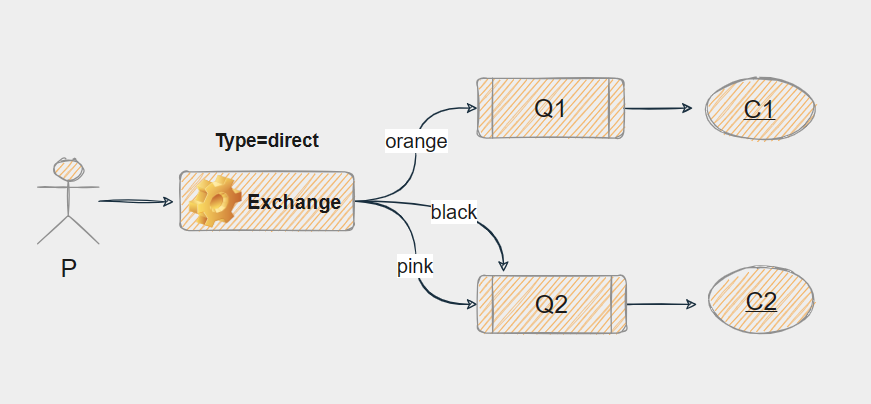
package com.ycxw.publisher.demos;import org.springframework.amqp.core.Binding;import org.springframework.amqp.core.BindingBuilder;import org.springframework.amqp.core.DirectExchange;import org.springframework.amqp.core.Queue;import org.springframework.context.annotation.Bean;import org.springframework.context.annotation.Configuration;//定义队列@Configuration@SuppressWarnings("all")public class RabbitConfig { /** * 定义队列 Q1 * @return */ @Bean public Queue directQ1() { return new Queue("direct-Q1"); } /** * 定义队列 Q2 * @return */ @Bean public Queue directQ2() { return new Queue("direct-Q2"); } /** * 自定义直连交换机 * @return */ @Bean public DirectExchange directExchange() { return new DirectExchange("direct-exchange", true, false); } /** * 将队列 Q1与交换机进行绑定,并设置路由键 * @return */ @Bean public Binding bindingQ1() { return BindingBuilder.bind(directQ1()) .to(directExchange()) .with("direct_orange"); } /** * 将队列 Q2与交换机进行绑定,并设置路由键 * @return */ @Bean public Binding bindingQ2() { return BindingBuilder.bind(directQ2()) .to(directExchange()) .with("direct_black"); }}package com.ycxw.publisher.demos;import com.fasterxml.jackson.core.JsonProcessingException;import com.fasterxml.jackson.databind.ObjectMapper;import org.springframework.amqp.core.AmqpTemplate;import org.springframework.beans.factory.annotation.Autowired;import org.springframework.web.bind.annotation.RequestMapping;import org.springframework.web.bind.annotation.RestController;/** * 模拟发送请求 */@RestControllerpublic class Sender { @Autowired private AmqpTemplate rabbitTemplate; @RequestMapping("/send1") public String sendFirst() { /*向消息队列发送消息 converAndSend(交换机,路由键,发送的信息)*/ rabbitTemplate.convertAndSend("direct-exchange", "direct_orange", "我是Q1"); return "?"; } @RequestMapping("/send2") public String sendSecond() throws JsonProcessingException { rabbitTemplate.convertAndSend("direct-exchange", "direct_black", "我是Q2"); return "?"; }}package com.ycxw.consumer.demos;import org.springframework.amqp.rabbit.annotation.RabbitHandler;import org.springframework.amqp.rabbit.annotation.RabbitListener;import org.springframework.stereotype.Component;@Component@RabbitListener(queues = {"direct-Q1"})public class DirectReceiver { @RabbitHandler public void handler(String msg) { System.out.println(msg); }}package com.ycxw.consumer.demos;import org.springframework.amqp.rabbit.annotation.RabbitHandler;import org.springframework.amqp.rabbit.annotation.RabbitListener;import org.springframework.stereotype.Component;@Component@RabbitListener(queues = {"direct-Q2"})public class DirectReceiver2 { @RabbitHandler public void handler(String msg) { System.out.println(msg); }}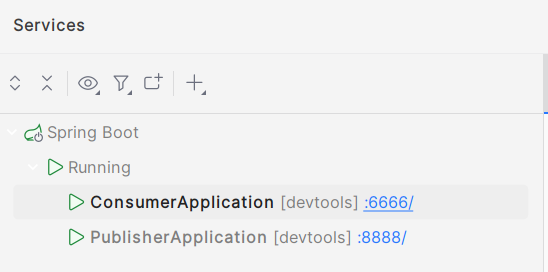
Q1队列:
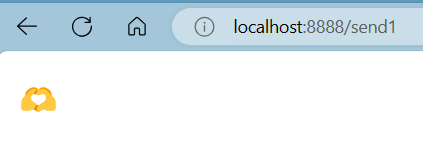
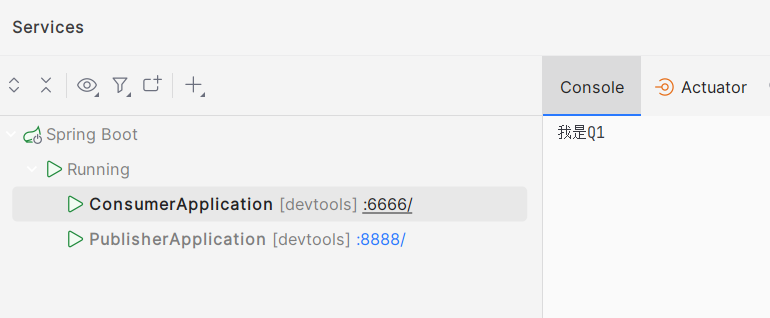
Q2队列:
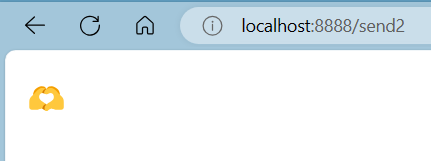
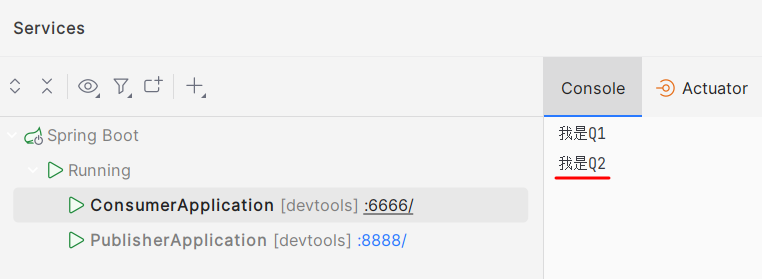
直连交换机适用场景:
有优先级的任务,根据任务的优先级把消息发送到对应的队列,这样可以指派更多的资源去处理高优先级的队列。
2. 主题交换机:Topic Exchange
直连交换机的缺点!
直连交换机的routing_key方案非常简单,如果我们希望一条消息发送给多个队列,那么这个交换机需要绑定上非常多的routing_key。假设每个交换机上都绑定一堆的routing_key连接到各个队列上,那么消息的管理就会异常地困难。所以RabbitMQ提供了一种主题交换机,发送到主题交换机上的消息需要携带指定规则的routing_key。
主题交换机的routing_key需要有一定的规则,交换机和队列的binding_key需要采用*.#.*.....的格式,每个部分用 . 分开,其中
* 表示一个单词 # 表示任意数量(零个或多个)单词。主题交换机会根据这个规则将数据发送到对应的(多个)队列上。
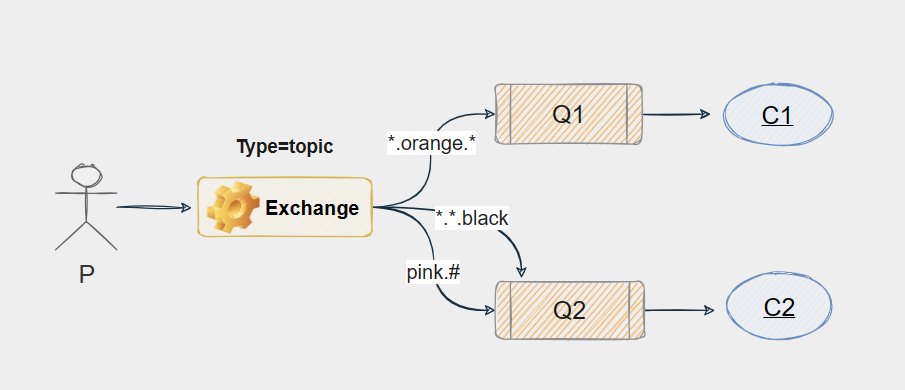
示例:
队列Q1绑定键为 *.orange.*队列Q2绑定键为 *.*.black 与 pink.# 如果一条消息携带的路由键为 a.orange.b,那么队列Q1将会收到 如果一条消息携带的路由键为 a.b.black 或 pink.a(pink.a.b、pink.abc.sb.as....),那么队列Q2将会收到如果想让Q1和Q2都接收到P发出的信息,那么路由键为 xx.orange.black 或 pink.orange.xx 生产者 /** * 定义路由键规则 */ public static String A_KEY ="*.orange.*"; public static String B_KEY ="*.*.black"; public static String C_KEY ="pink.#"; /** * 定义队列 Q1 * @return */ @Bean public Queue topicQ1() { return new Queue("topic-Q1"); } /** * 定义队列 Q2 * @return */ @Bean public Queue topicQ2() { return new Queue("topic-Q2"); } /** * 自定义主题交换机 * @return */ @Bean public TopicExchange topicExchange() { return new TopicExchange("topic-exchange", true, false); } @Bean public Binding topic_q1(){ return BindingBuilder.bind(topicQ1()) .to(topicExchange()) .with(A_KEY); } @Bean public Binding topic_q2(){ return BindingBuilder.bind(topicQ2()) .to(topicExchange()) .with(B_KEY); } @Bean public Binding topicq2(){ return BindingBuilder.bind(topicQ2()) .to(topicExchange()) .with(C_KEY); } /** * 同时绑定Q1、Q2 */ @Bean public Binding topicq1(){ return BindingBuilder.bind(topicQ1()) .to(topicExchange()) .with(C_KEY); }模拟发送请求:通过路劲传参(指定路由)
@RequestMapping("/send3") public String sendThree(@RequestParam String rex) throws JsonProcessingException { rabbitTemplate.convertAndSend("topic-exchange", rex, "hello"); return "?"; }package com.ycxw.consumer.demos; import org.springframework.amqp.rabbit.annotation.RabbitHandler;import org.springframework.amqp.rabbit.annotation.RabbitListener;import org.springframework.stereotype.Component; import java.util.Map;@Componentpublic class TopicReceiver { @RabbitListener(queues = {"topic-Q1"}) @RabbitHandler public void handler(String msg){ System.out.println("已接受到队列topic-Q1传递过来的消息:"+msg); } @RabbitListener(queues = {"topic-Q2"}) @RabbitHandler public void handlerB(String msg) { System.out.println("已接受到队列topic-Q2传递过来的消息:" + msg); }}Q1队列:


Q2队列:
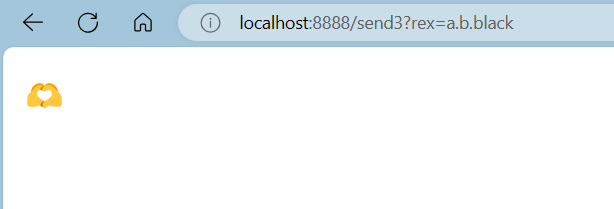

同时调用两个队列:
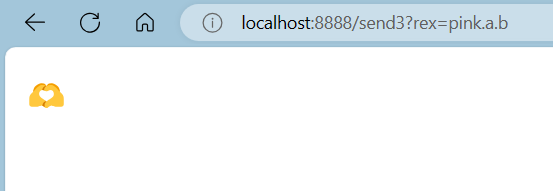

3. 扇形交换机:Fanout Exchange
扇形交换机是最基本的交换机类型,它所能做的事情非常简单———广播消息。
扇形交换机会把能接收到的消息全部发送给绑定在自己身上的队列。因为广播不需要“思考”,所以扇形交换机处理消息的速度也是所有的交换机类型里面最快的。
这个交换机没有路由键概念,就算你绑了路由键也是无视的。
注意!!!:扇形交换机没有路由键,所以发送请求会被所有绑定的交换机队列接收
生产者 /** * 定义队列 Q1 * @return */ @Bean public Queue fanoutQ1() { return new Queue("fanout-Q1"); } /** * 定义队列 Q2 * @return */ @Bean public Queue fanoutQ2() { return new Queue("fanout-Q2"); } /** * 定义扇形交换机 * @return */ @Bean public FanoutExchange fanoutExchange(){ return new FanoutExchange("fanout-exchange",true,false); } /** * 绑定队列 (没有路由键) * @return */ @Bean public Binding fanout_q1(){ return BindingBuilder.bind(fanoutQ1()) .to(fanoutExchange()); } @Bean public Binding fanout_q2(){ return BindingBuilder.bind(fanoutQ2()) .to(fanoutExchange()); } @RequestMapping("/send4") public String sendFour() throws JsonProcessingException { //必须填写路由键这项,否则接收不到信息。 //由于扇形交换机没有路由键,所以这向需要填空,不然会将发送的信息(hello)解析为路由键 rabbitTemplate.convertAndSend("fanout-exchange","","hello"); return "?"; }package com.ycxw.consumer.demos;import org.springframework.amqp.rabbit.annotation.RabbitHandler;import org.springframework.amqp.rabbit.annotation.RabbitListener;import org.springframework.stereotype.Component;@Componentpublic class FanoutReceiver { @RabbitListener(queues = {"fanout-Q1"}) @RabbitHandler public void handler(String msg) { System.out.println("已接受到队列fanout-Q1传递过来的消息:" + msg); } @RabbitListener(queues = {"fanout-Q2"}) @RabbitHandler public void handlerB(String msg) { System.out.println("已接受到队列fanout-Q2传递过来的消息:" + msg); }}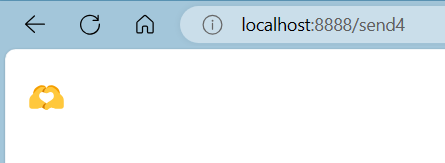

4. 默认交换机(直连)
实际上是一个由RabbitMQ预先声明好的名字为空字符串的直连交换机(direct exchange)。它有一个特殊的属性使得它对于简单应用特别有用处:那就是每个新建队列(queue)都会自动绑定到默认交换机上,绑定的路由键(routing key)名称与队列名称相同。
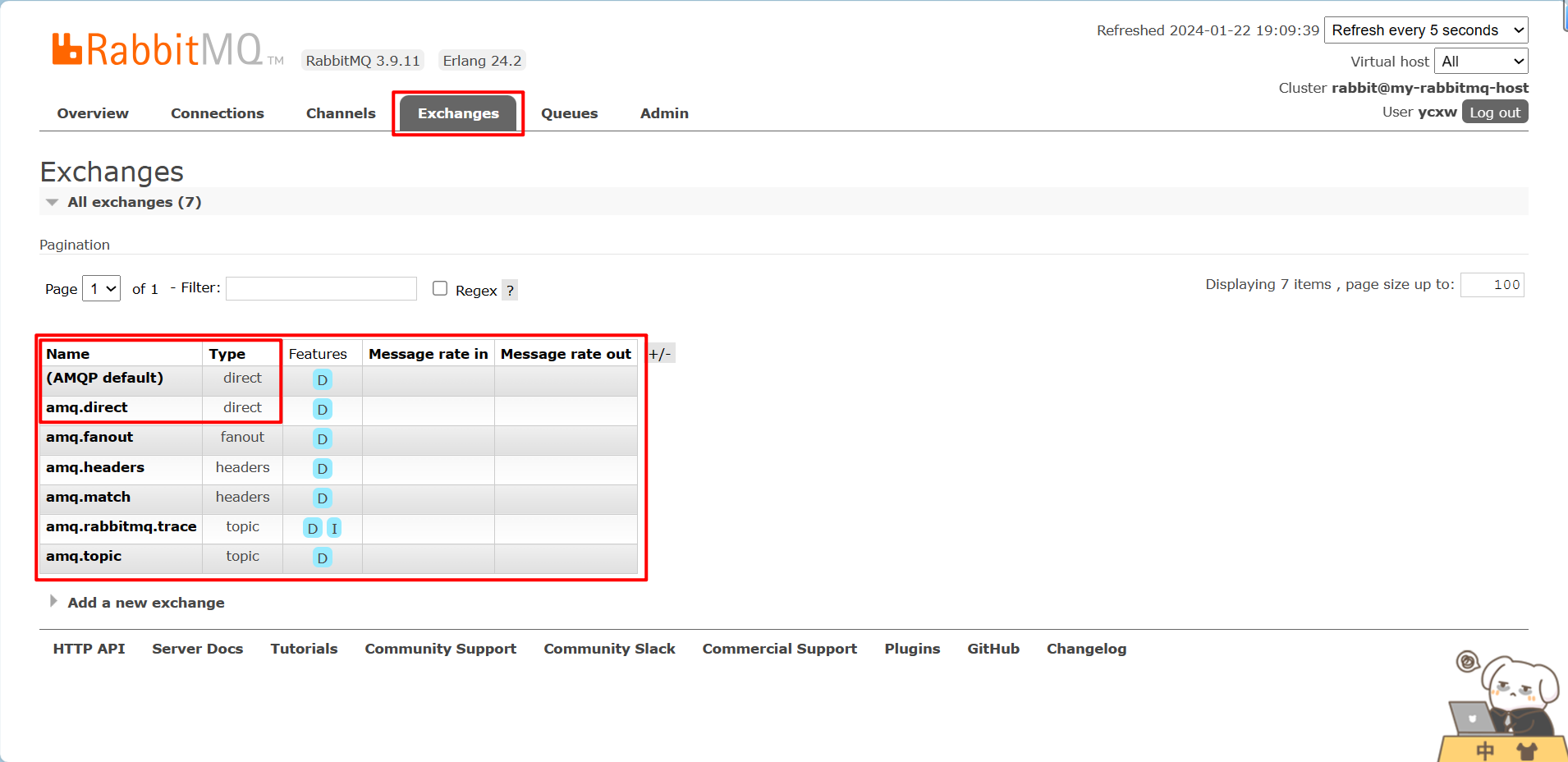
如:当你声明了一个名为”hello”的队列,RabbitMQ会自动将其绑定到默认交换机上,绑定(binding_key)的路由键名称也是为”hello”。
因此,当携带着名为”hello”的路由键的消息被发送到默认交换机的时候,此消息会被默认交换机路由至名为”hello”的队列中
类似amq.*的名称的交换机:
这些是RabbitMQ默认创建的交换机。这些队列名称被预留做RabbitMQ内部使用,不能被应用使用,否则抛出403 (ACCESS_REFUSED)错误